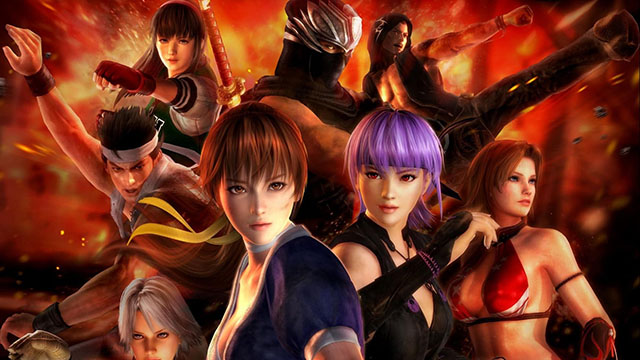Dead or Alive: A Deep Dive into the Busty Brawler Series
The Dead or Alive (DOA) series is a long-running fighting game franchise developed by Team Ninja (a division of Koei Tecmo Games). It’s known for a lot of things, but primarily for its visually striking characters, particularly its emphasis on realistic (and often exaggerated) female anatomy, and its unique fighting system. Here’s a comprehensive overview, covering its history, gameplay, characters, controversies, and current state:
History & Evolution
- Origins (1996 – DOA1): The series debuted in arcades in 1996 with Dead or Alive. It was a direct response to the popularity of Virtua Fighter and Tekken, aiming to offer a more visually dynamic and accessible 3D fighting experience. It immediately stood out for its focus on beautiful, realistically rendered characters.
- Early Success & 3D Innovation (DOA2 – 2000): Dead or Alive 2 on the Dreamcast was a breakthrough. It significantly improved the graphics, introduced the “Danger Zone” system (more on that later), and became a system seller for the Dreamcast. It also heavily featured interactive stages.
- Expanding the Universe (DOA3 – 2001, DOA4 – 2005): Dead or Alive 3 on the Xbox was a graphical powerhouse for its time, and continued refining the gameplay. Dead or Alive 4 brought the series to the Xbox 360, introducing online play and further refining the visual fidelity.
- Modern Era (DOA5 – 2012, DOA6 – 2019): Dead or Alive 5 was a major entry, receiving numerous updates and DLC, including collaborations with other franchises like Virtua Fighter. Dead or Alive 6 (the latest mainline entry) aimed for a more modern aesthetic and focused on story mode and character customization, but faced criticism for its monetization practices.
Gameplay Mechanics
- 3D Movement & Positioning: Unlike many 2D-based fighting games, Dead or Alive emphasizes full 3D movement. Players can sidestep, circle, and position themselves strategically to avoid attacks and create openings. This is a core element of the gameplay.
- The Danger Zone: A defining feature of the series. When a character is knocked into a wall or specific stage hazards, they enter the “Danger Zone.” Here, they are vulnerable to powerful “hold” attacks that can lead to dramatic takedowns and environmental damage.
- Hold System: The hold system is a key part of the Danger Zone, but also exists outside of it. Successfully holding an opponent can lead to a variety of outcomes, from simple throws to devastating slams.
- Counter System: Timing is crucial. Players can counter attacks with precise timing, leading to reversals and opportunities for counterattacks.
- Combo System: Combos are generally shorter and more focused on positioning and reads than in some other fighting games. The emphasis is on punishing mistakes and capitalizing on openings.
- Interactive Stages: Stages often feature destructible elements and hazards that can be used to your advantage. This adds another layer of strategic depth.
- Rock-Paper-Scissors Element: The game often features a subtle rock-paper-scissors dynamic in certain matchups and moves, encouraging players to learn and adapt.
Key Characters
The Dead or Alive roster is large and diverse, but some characters are particularly iconic:
- Kasumi: The protagonist of the series, a runaway ninja seeking to escape her clan. She’s the most recognizable face of Dead or Alive.
- Ayane: Another ninja, and a rival to Kasumi. Known for her speed and agility.
- Hayate: A skilled ninja and Kasumi’s brother. A powerful and versatile fighter.
- Ryu Hayabusa: A guest character from the Ninja Gaiden series, and a fan favorite. He’s a highly technical and powerful fighter.
- Tina Armstrong: A powerful wrestler known for her strength and dynamic moves.
- Lei Fang: A Chinese martial artist specializing in Bajiquan.
- Hitomi: A graceful and powerful fighter who uses a unique style of martial arts.
- Jacky Bryant: A capoeira master known for his acrobatic moves.
Controversies & Criticism
- Sexualization of Female Characters: This is the biggest and most persistent criticism of the series. The characters are often designed with exaggerated proportions and revealing outfits, leading to accusations of objectification and pandering. Team Ninja has defended their designs as artistic expression, but the controversy continues.
- Gameplay Depth vs. Visual Focus: Some critics argue that the series prioritizes visual spectacle over deep and nuanced gameplay. While the gameplay is solid, it’s often overshadowed by the focus on character design.
- Monetization (DOA6): Dead or Alive 6 received significant backlash for its aggressive monetization practices, including expensive DLC costumes and a battle pass system. This alienated many fans.
Current State & Future
- DOA6 is the latest mainline entry. While it received updates, it hasn’t seen major new content in a while.
- The series remains popular, particularly in Japan. It has a dedicated fanbase that appreciates its unique gameplay and visual style.
- Team Ninja is currently focused on the Nioh and Wo Long series. This has led to speculation about the future of Dead or Alive.
- There’s been no official announcement of a Dead or Alive 7, but the franchise isn’t dead (pun intended). Many fans hope for a return to form with a new entry that addresses the criticisms of DOA6 and builds upon the strengths of the series.
Where to Learn More
- Official Website (6): https://teamninja-studio.com/doa6/
- Dead or Alive Wiki: https://dead-or-alive.fandom.com/wiki/Dead_or_Alive_Wiki
- YouTube (Gameplay & Tutorials): Search for “Dead or Alive gameplay” or specific character tutorials.
In conclusion, Dead or Alive is a unique and often controversial fighting game series. It’s known for its stunning visuals, innovative gameplay, and, unfortunately, its often-criticized sexualization of its characters. Despite its flaws, it remains a popular and influential franchise with a dedicated fanbase. Whether you’re drawn to its fast-paced action, its beautiful characters, or its strategic depth, Dead or Alive offers a fighting game experience unlike any other.
